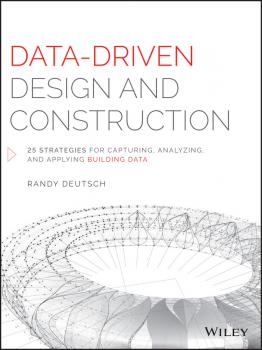ТОП просматриваемых книг сайта:
Randy Deutsch
Список книг автора Randy DeutschАннотация
"There is today a pronounced and accelerated convergence in architecture. This convergence is occurring by doers not thinkers; in practice not academia; in building design, fabrication, and construction. It is about solution-centric individuals engaged in real time problem solving, not in abstractions. The nature of this convergence, where things are converging and what that means for architecture, is the subject of this book." —from the Introduction Those working in architecture and engineering feel pressure to work faster, at lower cost, while maintaining a high level of innovation and quality. At the same time, emergent tools and processes make this possible. Convergence is about the firms, teams and people who thrive in this environment as a result of their ability to creatively combine and innovate. It seeks to answer several timely questions: What are the tools and work processes that are converging? How are individuals and organizations converging their tools and work processes? What challenges and benefits are they seeing? What is the ultimate endgame of this convergence? What skillsets and mindsets would someone need to develop to work effectively in this changing environment? What are the implications of convergence on the role of the designer, and on design? On how we design, build, fabricate, and construct? On how we work? The book explains how convergence relates to, but ultimately differs from integration, consolidation, multi-tasking, automation, and other forms of optimization. The practice-based research builds upon the author’s research in BIM and in the collaborative leveraging of data in design and fabrication. As an investigation and meditation on the impact of technology on the education and making of design professionals Convergence explains what is happening in the world of design, and discusses the implications for the future of education, training and practice.
Data-Driven Design and Construction. 25 Strategies for Capturing, Analyzing and Applying Building Data - Randy Deutsch
Аннотация
“In this comprehensive book, Professor Randy Deutsch has unlocked and laid bare the twenty-first century codice nascosto of architecture. It is data. Big data. Data as driver. . .This book offers us the chance to become informed and knowledgeable pursuers of data and the opportunities it offers to making architecture a wonderful, useful, and smart art form.” —From the Foreword by James Timberlake, FAIA Written for architects, engineers, contractors, owners, and educators, and based on today’s technology and practices, Data-Driven Design and Construction: 25 Strategies for Capturing, Applying and Analyzing Building Data addresses how innovative individuals and firms are using data to remain competitive while advancing their practices. seeks to address and rectify a gap in our learning, by explaining to architects, engineers, contractors and owners—and students of these fields—how to acquire and use data to make more informed decisions. documents how data-driven design is the new frontier of the convergence between BIM and architectural computational analyses and associated tools. is a book of adaptable strategies you and your organization can apply today to make the most of the data you have at your fingertips. Data-Driven Design and Construction was written to help design practitioners and their project teams make better use of BIM, and leverage data throughout the building lifecycle.
Аннотация
“Ready or not, it’s high time to make BIM a part of your practice, or at least your vocabulary, and this book has as much to offer beginners as it does seasoned users of building information modeling software.” —Chicago Architect The first book devoted to the subject of how BIM affects individuals and organizations working within the ever-changing construction industry, BIM and Integrated Design discusses the implementation of building information modeling software as a cultural process with a focus on the technology’s impact and transformative effect—both potentially disruptive and liberating—on the social, psychological, and practical aspects of the workplace. BIM and Integrated Design answers the questions that BIM poses to the firm that adopts it. Through thorough research and a series of case study interviews with industry leaders—and leaders in the making out from behind the monitor—BIM and Integrated Design helps you learn: Effective learning strategies for fully understanding BIM software and its use Key points about integrated design to help you promote the process to owners and your team How BIM changes not only the technology, process, and delivery but also the leadership playing field How to become a more effective leader no matter where you find yourself in the organization or on the project team How the introduction of BIM into the workforce has significant education, recruitment, and training implications Covering all of the human issues brought about or exacerbated by the advent of BIM into the architecture workplace, profession, and industry, BIM and Integrated Design shows how to overcome real and perceived barriers to its use.



